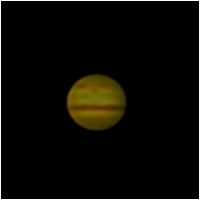
'Iuppiter est quodcumque vides, quocumque movis.'
Marcus Annĉus Lucanus, Pharsalia bk. 9, I. 580 (62)
* * *
J U P I T E RStanley Kubrick, 2001: A Space Odyssey (1965 film)
A selection of my observations of the giant planet Jupiter, which took me some time to get to grips with. Over five times further from the Sun than the Earth, Jupiter is eleven times as wide as the Earth and as such is the largest planet in the Solar System and by far the most massive, containing well over twice the amount of matter contained in all of the other planets together. Below the surface atmospheric layers, the planet is a colossal grapefruit of chiefly hydrogen gas, which deep in the interior must be so highly pressurized that it becomes a liquid electrical conductor, a dark internal ocean of metallic hydrogen. Finally it is supposed that there is a rocky core trapped in the centre of this ocean. Spectroscopic analysis of the visible thick surface clouds shows that they are composed of ammonia crystals, interspersed with hydrogen, helium, methane, water ice, ethane, acetylene, phosphine, carbon monoxide, hydrogen sulphide, hydrogen cyanide, and germanium hydride. It is thought that phosphine is responsible for the red and brown colours in the Jovian cloud belts, possibly breaking down into red phosphorus under the action of ultraviolet light from the Sun. Colours might also be produced by complex hydrocarbons in the upper atmosphere produced from methane and ammonia.
Jupiter has been described as a failed star, and although this is a misleading description and Jupiter could never have become a star, had Jupiter become a star and the Solar System become a binary system, dark nights on Earth would have been far less frequent. For seven months out of every twelve there would be no night at all, and nights would be shorter when they came, between Jupiterset and Sunrise, or Sunset and Jupiterrise, depending on which side of the Sun Jupiter was situated. Only at conjunction, when Jupiter is in the same part of the sky as the Sun, would the Earth experience a full night, and longest nights would be rare events indeed, only occurring when Jupiter conjunction coincided with Earth's winter solstice. It is interesting to consider the course evolution might have taken in such a world, and the complex implications for the daily and seasonal calendar and human understanding of its causes, and of course for astronomy.
Although they had no way of knowing that it is the largest planet in the Solar System, the planet was named by the Romans after their chief god Jupiter (Latin Iuppiter). The word stems from the proto-Indo-European "dyeu-phater" meaning "god-father".
Observation #191, 2010.XI.19

Another image of Jupiter, with the Great Red Spot in plain sight without any help from the blue filter. The GRS is particularly prominent at the moment since the South Equatorial Belt (below it in the picture) is faded for the present.
* * *
Observation #179, 2010.IX.14
CCD footage of Jupiter and satellites, experimenting with camera settings.
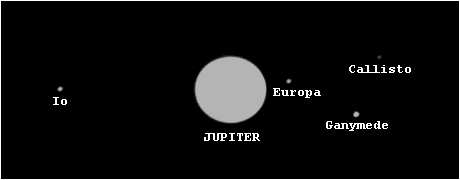
JOVIAN SYSTEM
2010.IX.14.2139 UT
Managed to capture a clear image of the Galilean satellites for the first time.
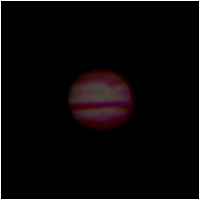
However the image of Jupiter is poor. The Great Red Spot is plain enough to see.
* * *
Observation #174, 2010.VIII.23-4
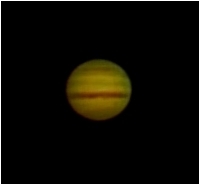
After two years of intermittent struggle, finally I took this useful image of the giant planet Jupiter, showing the major cloud systems. The obvious dark maroon band is the North Equatorial Belt or NEB, which currently appears to be pronounced, and much subtle detail is apparent at the edges of this belt. The corresponding South Equatorial Belt just above the equator, appears faint, to the southwest (top right) the belt tapers downwards forming the Red Spot Hollow, and the Great Red Spot itself can be seen just emerging into daylight above the SEB at the edge of the disc, the first time I have managed to image the phenomenon. The GRS is a gigantic oval whirling storm about 20,000 miles long by 8,000 miles wide, so that its surface area is about the same as that of the entire Earth. It has been known since the first telescopic observations of Jupiter, and whilst it varies in size, colour and prominence, over the last century the Spot has been seen to be slowly shrinking. In the events known as SEB fades, the GRS darkens and becomes more prominent, whilst the SEB can fade almost altogether, covered up by white clouds of ammonia crystals. After anything up to three years, the underlying darker clouds eventually burst through the surface ammonia in spectacular storms during 'SEB revival' events. At the present time it appears that an SEB fade is under way, and the GRS is becoming more prominent.
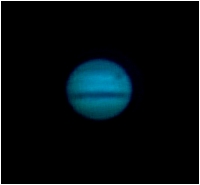
Thirty-seven minutes after taking the first image, the GRS is well in daylight and visible on the Jovian disc. This image was taken with a Wratten #38A Dark Blue filter, which blocks red light from the GRS and transmits blue light from the surrounding ammonia clouds, thus making the GRS stand out as darker and more obvious.
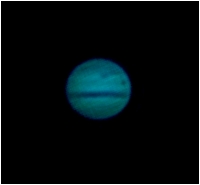
* * *
Observation #173, 2010.VII.22
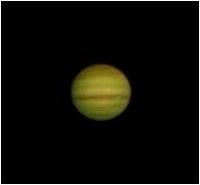
This was the first time I was ever able to image Jupiter with a refractor, and still there is still some way to go before I can be satisfied that I have the best possible image. Jupiter was low and just over some distant tree tops, and occasionally was obscured by a twig, and there was some cloud about which eventually spoiled observations. If I had time and a clear shot at Jupiter I could take multiple images under different colour filters. Then all I have to do is work out how to combine them. Incidentally, the Great Red Spot, which I have never caught, is as usual on the other side of the planet.
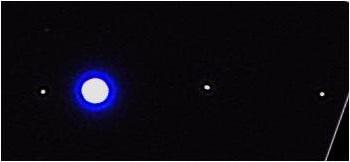
JOVIAN SYSTEM
2010.VII.22.0201 UT
An over-exposed image of the Jovian system showing three of the Galilean satellites, Io is right, Ganymede left, Callisto far left. Europa is behind Jupiter. The fainter object in the top left corner above Io is in fact the background star HIP1127, an eighth magnitude star at a distance of over 1,000 light-years. This bodes well for imaging faint objects.
* * *
Observation #120, 2009.VIII.8
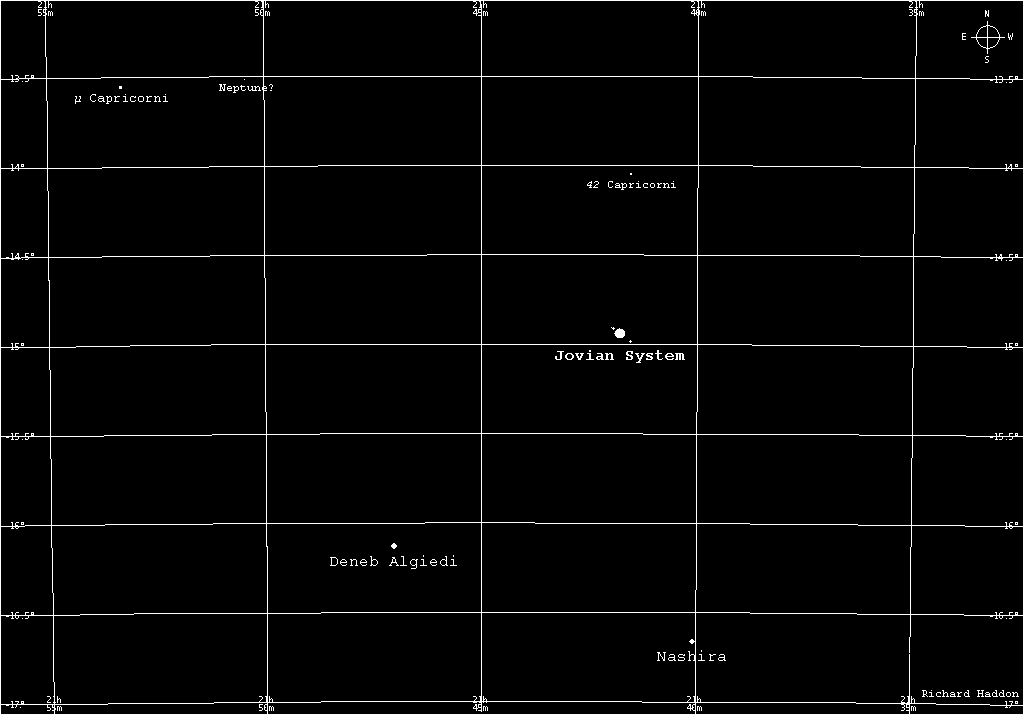
Link to chart of Jovian System as seen through 8×30mm binoculars
at 2009.VIII.8.0246 UT in light polluted skies
(This chart was made using screenshots from CNebulaX and Starry Night Backyard 3.1)
0328
Looking at Jupiter low in the southwest, played with the binocular focus in order to discern whether or not the blob of light which Jupiter presents through binoculars could be resolved into anything like a disc. In fact a disc was plainly apparent, and so too was what appeared to be a Galilean satellite to the right of the disc. I was not certain of the presence of the satellite at first, and first suspected that the satellites might be too close to Jupiter at 8× magnification to separate them, and that what I was seeing was either an internal reflection in the binoculars or a background star, which shows how much I know about the capabilities of my own optical equipment. But keeping the binoculars steady and moving the image in and out of focus confirmed that there was definitely a star-like point visible immediately to the right of Jupiter. Indeed I also observed a second such point closer in towards Jupiter on the exact opposite left side of the planet. At this point I went indoors to check the positions of the Galilean satellites on the computer.
0334
Confirmed that it is perfectly possible to observe the Galilean satellites with 8× binoculars; the star-like point to the right of Jupiter could only be Ganymede, and the point on the left of Jupiter was clearly Io. In fact the computer showed that Io and Europa appeared quite close together as seen from Earth, with Callisto further out to the left. Returning outside, it was quite impossible to separate Io and Europa with binoculars, whilst Callisto was just about visible next to them like a faint and very close double image of Io, although according to the computer Europa was almost 274,000 miles removed from Io at the time, and Callisto well over a million miles away. But then Jupiter himself was over 375 million miles removed from my observing position in my back porch on Earth.
* * *
Observation #117, 2009.VI.18
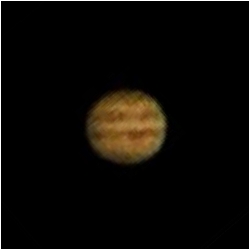
Managed to catch Jupiter at dawn with the sky turning blue and without a single star left in it. My imaging is improving but is still somewhat disappointing.

This is a chart showing the relative positions of Jupiter, the Earth, and the Sun at this time. Jupiter was 415,745,000 miles distant, and subtending a relatively large 44" of arc. At opposition Jupiter can subtend 50" of arc; aside from the Sun and the Moon, only Venus can appear larger than this.
* * *
Observation #59, 2008.VIII.30
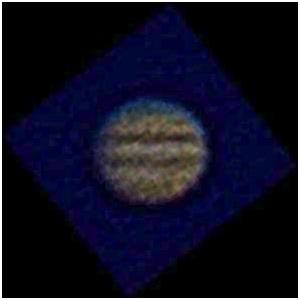
The last CCD picture of Jupiter I was able to take before I ended my study of Jupiter for the year, having at that time yet to master the intricacies and subtleties of the image capture device and of the image processing software I use with it.
* * *
Observation #55, 2008.VII.22
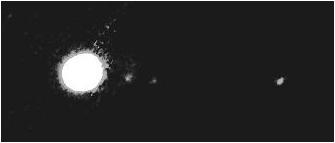
JOVIAN SYSTEM
2008.VII.22.2334 UT
My first attempt to use a CCD (charge coupled device) in astrophotography. In this over-exposed image of Jupiter, the Galilean satellites Io, Europa, and Ganymede are visible respectively with increasing distance from the planet.
* * *
Observation #53, 2008.VII.1
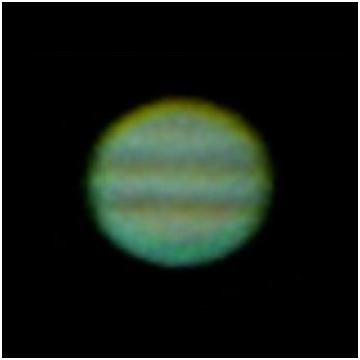
An early attempt at astrophotography, using processed footage taken by holding up my mobile phone camera to the telescope eyepiece.
* * *
Observation #22, 2007.VIII.26
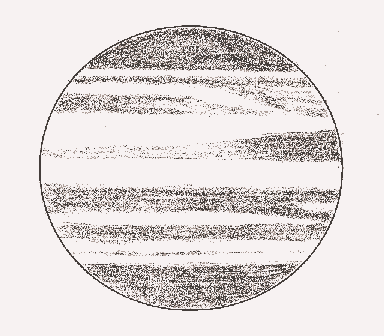
I ought to explain that these are my first attempts at sketching any planet. Observing the surface details can be very difficult; they only show up faintly and after waiting patiently for a moment of stillness in the Earth's atmosphere above.
* * *
Observation #21, 2007.VIII.10
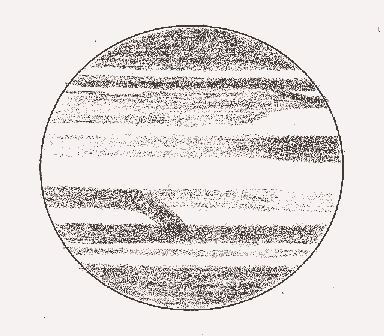
* * *
Observation #20, 2007.VIII.9
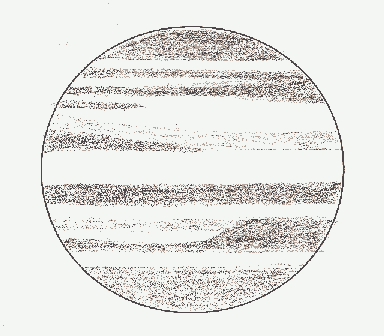
* * *
Observation #2, 2006.V.31
2304 (BST) [At this stage I did not realize that in timing astronomical observations, no matter where in the world or indeed the universe you are observing from, the convention is to quote all times in Universal Time (UT), and not in local time. UT is the same as GMT (Greenwich Mean Time) which is one hour behind the local British Summer Time (BST) which I am using here.]
Clearer image of Jupiter than previous night. Galilean satellites had moved all over the place. Ganymede had moved closer to Jupiter from the right and was not as bright as the previous night. Callisto had moved in from the left. Europa was the other side of Jupiter and brighter. Io was missing, in fact Io was in front of Jupiter, but I didn't see him.
2315
Made out more detail on Jupiter. Two distinct dark equatorial belts, lower one (northern) slightly thicker in the left middle? Higher one apparently uniform with no sign of the Great Red Spot. Dark caps over both poles. Could just about see gradations of colour and thin whitish belts across the rest of the globe, but these were indistinct and drifted in and out of focus.
2319
Was startled by a bright object suddenly moving in a wobbly more or less straight line quickly past Jupiter from bottom to top (north to south). There was no noticeable trail, but the object did have a very short triangular tail. The object must have taken a full second to cross the field of vision at magnification ×80. Like an arrogant drunk rudely staggering through a private conversation at a party. One would assume that any object in the northern sky moving rapidly north to south would be something falling to Earth, only I would have thought that a falling star would have moved faster, would have flashed past in a straight line without wobbling erratically and would have burned brighter, leaving a trail, especially at this magnification. If it were not for the wobbling motion I would have assumed that the object was an artificial satellite, but I assume that such an object would move in a perfectly straight line. But then again so would a meteoroid pulled in by the Earth's gravity, hurtling through the atmosphere, or would it? I can only assume that this was a large, sporadic meteoroid, burning up in the atmosphere as it descended to Earth, buffeted from side to side by winds on its way down. I really didn't think it was worth reporting a Unidentified Flying Object sighting to the Ministry of Defence over, and since I didn't hear a loud bang soon after it moved out of view, I don't think that it's worth worrying about any further. [Actually it is worth investigating; I only saw this phenomenon the second time I used a telescope and have never seen anything like it since, and I can't explain it satisfactorily yet. When I get around to it I will email an astronomer who knows about meteors (and not some quack UFO-hunter).]
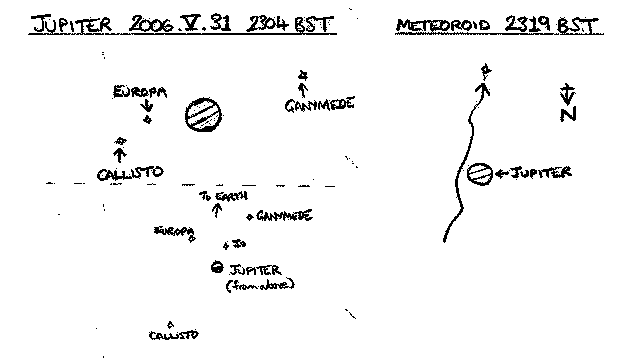
* * *
Observation #1, 2006.V.30
[This was my very first attempt at using an astronomical telescope.]
2230 (BST)
Jupiter moving in and out of cloud.
2245
Managed to scope Jupiter with finderscope.
2255
With the finderscope not calibrated yet, had to look for Jupiter and managed to chance upon him with the main telescope bang centre. Focussed image with 20mm eyepiece and... had to pace up and down the room making several expressions of amazement out loud. Jupiter resolved as a small disc, almost as bright as the Moon with two faint belts visible across it above and below the equator. Amazement was due to the clarity of Jupiter's moons, all four Galilean moons being plainly visible as finely-resolved pinpoints of light. I might have spent my whole life without ever seeing the moons of another planet; it was about time I got round to it. Momentous. No doubt about it then. Jupiter certainly has at least four satellites, is the centre of its own system and everything in the heavens does not necessarily revolve around the Earth. QED.
2300
Switched to 10mm eyepiece. Jupiter now twice the size but disappointingly no more clearly resolved. Galilean moons stretch right across field of vision. Callisto (far left) and Ganymede (far right) are brightest. Europa (right) fainter and Io (near left) very faint. Large cloud then obscured view.
2340
Had time to take a hard look at Jupiter before cloud intervened again. At this magnification (×80) the planet moves across the field of view every thirty seconds or a minute or so (due to the Earth's rotation) and the image 'swims' slightly as it does so. Image seems clear but too bright; Jupiter appears silver like the Moon but with two brownish belts and a dark cap at the North Pole (bottom). Image is too small to observe any spots.

You should return to the index page, if you have not yet found what you seek.